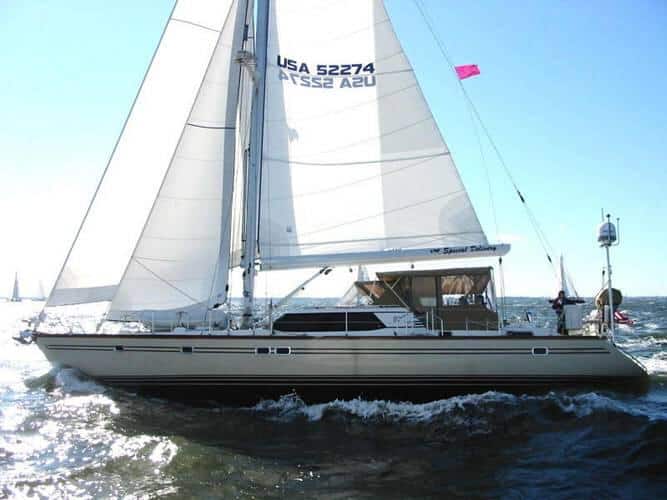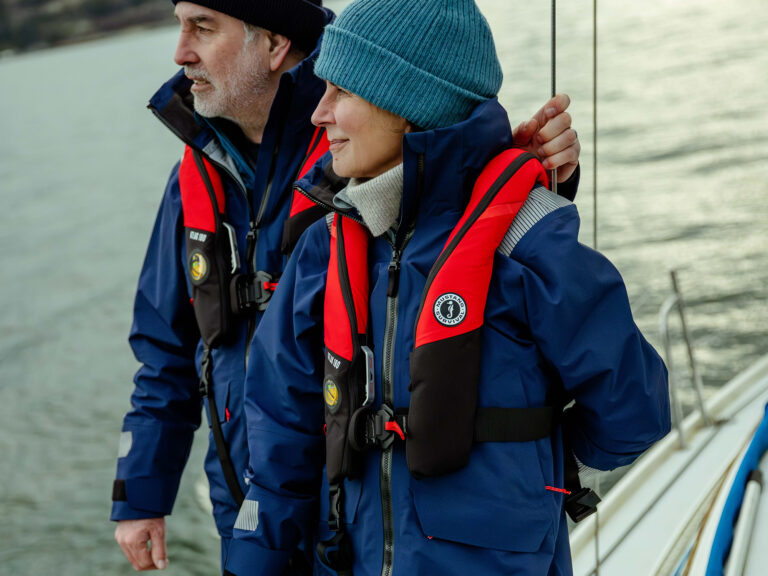
This design is part and parcel of Taswell’s “All Season” series of mid-cockpit long-range performance cruisers and is an adaptation of the Taswell 56, both of which follow the tradition of two earlier Taswells, the 43 and 49, all designed by British naval architect Bill Dixon. The 58 also features the center cockpit that has become a Taswell signature, along with the builder’s upscale nod to big-ticket items such as rich teak decks, a plush interior and premium gear. Notable about the 58 is its coach roof — raised to enhance volume below and to accommodate a second helm station that is fully protected, yet it’s swept back to maintain the vessel’s outwardly sleek, low-profile aesthetics.
Construction is to Lloyd’s specifications; an ABS ticket is available (with extra charge). The hull is composed of solid GRP laid up by hand, with 10 foam-filled longitudinal stringers and 10 high-density PVC-foam-cored transverse floors glassed in for structural rigidity, plus unidirectional tape applied as reinforcement. The three outermost layers of laminate feature vinylester resin for its proven resistance to osmotic penetration. The deck and cabin structure are cored with end-grain balsa to keep them light and stiff, with marine plywood substituted wherever fittings and hardware are secured. The deck is secured to the hull’s inturned flange with 3M 5200 bedding and stainless steel thru-bolts. The 58 we evaluated was fitted with well-pronounced teak toe-rails in lieu of standard aluminum — a striking detail against oiled teak decks.
Dixon’s hull form features a fine entry forward, a longish, externally mounted Scheel keel, gently rounded sections aft and a large skeg-hung rudder at the back of the bus. The footprint concentrates beam amidship between conventionally tapered ends, which favors seakindly behavior in ocean conditions and good performance to weather. This is consistent with the sail plan — mast forward; large high-aspect mainsail; reduced foretriangle; and intermediate staysail stay so she is cutter-capable. In contrast to a skittish, modern-day sled, the 58 is designed to chug resolutely upwind, delivering predictable, forgiving offshore cruising performance.
The Taswell 58 we inspected was chockablock full of hydraulics, electronics, mechanical equipment, miles of plumbing options…you name it. We had some concern about the inevitable complexity of maintaining it all, particularly given the notion that access to primary systems is compromised by the abundance of ancillary ones. On the other hand, installations overall are meticulous and all components are tops. The house plumbing features hot and cold running water by way of a 12-volt freshwater pump, two accumulator tanks, and a 15-gallon engine-routed hotwater heater.
The boat’s electrical power is run through a comprehensive Bass distribution panel, available in 12V-DC/110V-AC or 12V-DC/220V-AC. A masterfully executed hydraulics system aboard the test boat spun everything from the Lewmar winches flanking the cockpit to the windlass and custom stainless steel Harken roller furler on the bow. Given the semi-custom bent of the 58, you can configure the boat mechanically and electrically in any number of ways; if you want it all, you can have it.
In addition, the standard 140-horsepower Yanmar 4LH-HTE and optional generator package are well up to the task of doing the extra work; they are located in a vented, foam-and-lead insulated compartment behind the main companionway, accessed through a hatch panel on the starboard side across from the nav station. The battery bank (a mother lode of power storage comprising four 200-amp-hour house batteries and a single 120-amp-hour engine-starting unit) are all contained in dedicated fiberglass battery boxes to keep them from moving or shifting underway.
The interior is plush without being overstated or overembellished. Bulkheads are veneered in soft-toned, honey-colored teak; the overheads are covered with off-white Majilite vinyl and teak battens; laminated teak and spruce adorn the cabin sole. Of the three basic accommodation plans, two incorporate a second steering station in the upper saloon. All the layouts include queen-size berths in two primary staterooms, one forward and one aft, plus additional quarters with bunks in a smaller stateroom on the port side just forward of the main saloon. There are two capacious heads with showers; one belongs privately to the after cabin, the other services the forward and main cabins. The nav station occupies a roomy niche to starboard and aft at the foot of the companionway. The galley is located to port, either in a U-shaped enclave forward of the main settee or in a smaller L-shaped enclave aft and to port of the companionway; the latter arrangement results in a galley that, arguably, is a bit cramped for a vessel of this grandeur and scale.
The 58 is intelligently composed on deck. With all the bells and whistles in working order, a shorthanded crew can easily sail her from within the sheltered cockpit. All halyards and reefing paraphernalia lead aft by way of organizers across the cabintop. The mainsail is sheeted from the end of the boom to a traveler just aft of the cockpit coaming. Primaries are located within reach of the helm.
We were impressed with the refinement of the boat and its ability to move out and track, even in light to moderate air, and we found the beefy skeg-hung rudder to be responsive.
This is a well-designed boat, on a large scale, that will make your jaw drop when you go aboard.








